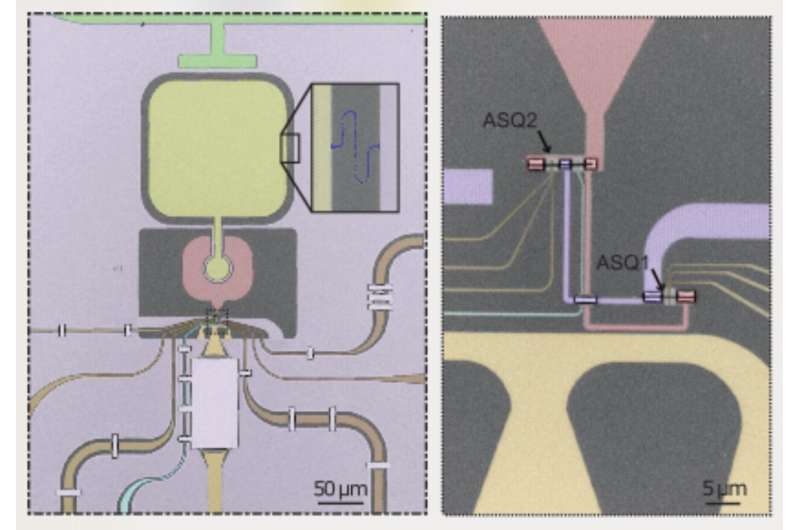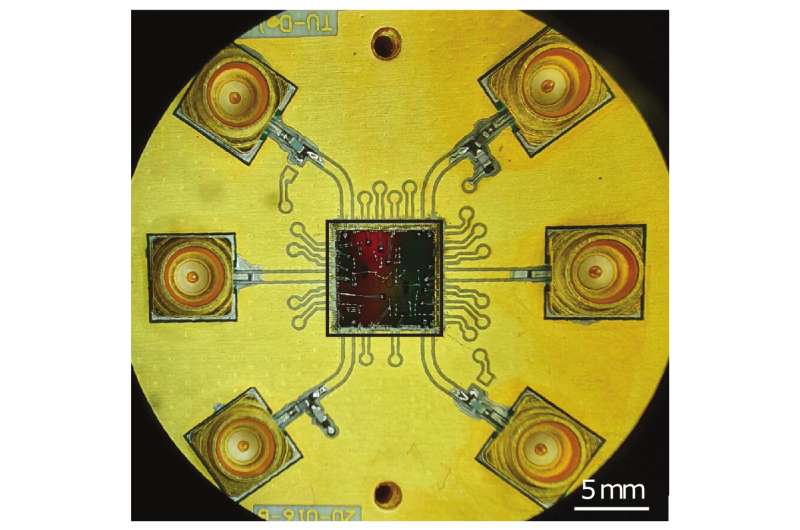May 22, 2024 feature
This article has been reviewed according to Science X's editorial process and policies. Editors have highlighted the following attributes while ensuring the content's credibility:
fact-checked
peer-reviewed publication
trusted source
proofread
The tunable coupling of two distant superconducting spin qubits

Quantum computers, computing devices that leverage the principles of quantum mechanics, could outperform classical computing on some complex optimization and processing tasks. In quantum computers, classical units of information (bits), which can either have a value of 1 or 0, are substituted by quantum bits or qubits, which can be in a mixture of both 0 and 1 simultaneously.
Qubits have so far been realized using various physical systems, ranging from electrons to photons and ions. In recent years, some quantum physicists have been experimenting with a new kind of qubits, known as Andreev spin qubits. These qubits leverage the properties of superconducting and semiconductor materials to store and manipulate quantum information.
A team of researchers at Delft University of Technology, led by Marta Pita-Vidal and Jaap J. Wesdorp, recently demonstrated the strong and tunable coupling between two distant Andreev spin qubits. Their paper, published in Nature Physics, could pave the way towards the effective realization of two-qubit gates between distant spins.
"The recent work is essentially a continuation of our work published last year in Nature Physics," Christian Kraglund Andersen, corresponding author of the paper, told Phys.org. "In this earlier work, we studied a new type of qubit called an Andreev spin qubit, which was also previously demonstrated by researchers at Yale."
Andreev spin qubits simultaneously leverage the advantageous properties of both superconducting and semiconductor qubits. These qubits are essentially created by embedding a quantum dot into a superconducting qubit.
"With the new qubit established, the natural next question was if we could couple two of them," Andersen said. "A theoretical paper published in 2010 suggested a method to couple two such qubits, and our experiment is the first experiment to realize this proposal in the real world."

As part of their study, Andersen and his colleagues first fabricated a superconducting circuit. Subsequently, they deposited two semiconductor nanowires on top of this circuit using a precisely controlled needle.
"The way we designed the circuit, the combined nanowire and superconducting circuits created two superconducting loops," Andersen explained. "The special part of these loops is that a part of each loop is a semiconductor quantum dot. In the quantum dot, we can trap an electron. The cool thing is that the current that flows around the loops will now depend on the spin of the trapped electron. This effect is interesting, as it allows us to control a supercurrent of billions of Cooper pairs with a single spin."
The combined current of the two coupled superconducting loops realized by the researchers ultimately depends on the spin in both the quantum dots. This also means that the two spins are coupled via this supercurrent. Notably, this coupling can also be easily controlled, either via the magnetic field running through the loops or by modulating the gate voltage.
"We demonstrated that we can really couple spins over 'long' distances using a superconductor," Andersen said. "Normally, spin-spin coupling only happens when two electrons are very close. When comparing qubit platforms based on semiconductors to those based on superconducting qubits, this requirement of proximity is one of the architectural downsides of semiconductors."
Superconducting qubits are known to be bulky, thus taking up lots of space within a device. The new approach introduced by Andersen and his colleagues allows for greater flexibility in the design of quantum computers, by enabling the coupling of qubits over long distances and the packing of them closer together.
This recent study could soon open new possibilities for the development of highly performing quantum computing devices. In their next studies, the researchers plan to extend their proposed approach to a larger number of qubits.
"We have very good reason to think that our approach could offer significant architectural advances for the coupling of multiple spin qubits," Andersen added. "However, there are also experimental challenges. The current coherence times are not very good, and we expect that the nuclear spin bath of the semiconductor that we used (InAs) is to blame. So, we would like to move to a cleaner platform, for example based on germanium, to boost the coherence times."
More information: Marta Pita-Vidal et al, Strong tunable coupling between two distant superconducting spin qubits, Nature Physics (2024). DOI: 10.1038/s41567-024-02497-x
Journal information: Nature Physics
© 2024 Science X Network





















